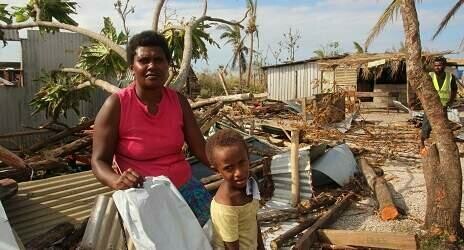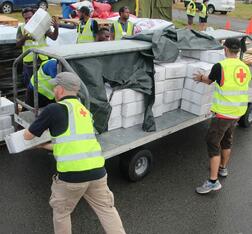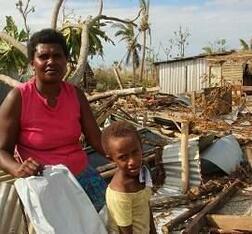
Vanuatu, a small island archipelago in the vast Pacific Ocean, has for many years worn the crown as the most disaster prone country in the world. Earthquakes, volcanos and storms are an everyday reality for its inhabitants. However the ferocity of the recent Tropical Cyclone Pam which slammed into the country last month, tested the preparedness of the country to respond and the global humanitarian system to assist.
Outside assistance poured into the country, it came from its neighbours in the Pacific and from around the world. It came in the form of tarpaulins, shelter kits, clean drinking water and humanitarian workers, from as close as nearby Fiji to as far as remote Finland. Despite this outpouring of good will and finely honed international response tools, the relief operations were not without their challenges.
Like the case of many island states, Vanuatu’s geographical isolation imposes not only logistical challenges to international aid relief but its small size means that coordination and communication are vital elements of a national-led response. Finding and maintaining this balance is key, and the parameters for this ideally should be in place before disaster strikes. However, this is not always the case, and legal and policy preparedness for international disaster response are not always considered.
Luckily this was not the case for Vanuatu. Since 2011, Vanuatu Red Cross, with the support of IFRC, had been working with its government to strengthen legal preparedness for international disaster response, commonly called IDRL. Vanuatu was the first country in the Pacific to undertake such a review. Although the recommendations contained in the Vanuatu IDRL had not been adopted into law before Pam struck, the government has kept the recommendations close at hand and had been implementing some of its recommendations into procedures used in response to the storm.
Within the first few days after Cyclone Pam struck, plane loads of international response teams and relief supplies poured into Vanuatu, filling up commercial and military flights and available accommodation on the island. Many relief agencies got down to business quickly, running assessments and commencing operations. Although international efforts were welcomed, the government was adamant on the need for good coordination with its well established national systems. As with most disaster responses, coordination of a multitude of different actors and agencies was not without its challenges in the initial phases, however now, there is a much more streamlined process for international actors seeking to support and complement the government led response.
A significant support to Vanuatu’s response was the existence of the Vanuatu Humanitarian Team (VHT) – which is Vanuatu’s domestic cluster system. The VHT was established late 2011 as a collaboration between Vanuatu based NGOs, the Red Cross, UN and government agencies. Coordinated by Oxfam with OCHA Regional Office Pacific support, it is focused on improving the coordination of humanitarian preparedness and response in support of government agencies in disasters. Government line ministries act in cluster lead roles in emergencies and VHT members act as co-leads. The VHT is recognized as a key coordination mechanism in Vanuatu and is also included in Government plans.
This system means that there are already established focal points for each of the clusters who have existing knowledge of the needs and capacities on the ground, international responders simply come under the relevant existing cluster to provide support and fill in any gaps. There are regular inter-cluster meetings to ensure all clusters are aware of each other’s work and this has significantly enhanced coordination and reduced duplication. They also set up a humanitarian registration desk at Port Vila airport to register all international humanitarian responders provide information on relevant cluster meetings, dates and venues, and even offer free sim cards.
As for my work here, I arrived in Vanuatu ten days after Cyclone Pam hit to support Vanuatu’s National Disaster Management Office (NDMO) on legal issues regarding international assistance. Since this time, I have been working with the Logistics Cluster, essentially doing “legal patchwork” and drafting procedures for international assistance where gaps have been identified, for example a letter outlining guidelines for unsolicited goods, customs and medical procedures for international responders. There is general agreement that Vanuatu would benefit from some robust Standard Operating Procedures (SOPs) on international assistance which I have also started working on. In the long term, the government have expressed interest in legislative reform and implementing the recommendations of the IDRL report. For now however, a first step is the development of these practical guidelines.
Coming from a small island state myself, I understand the realities of working in environments where bigger is not always better and where coordination and relationships are critical. A message I have for other small island states out there, is “be prepared”. The likelihood of such massive disasters hitting our countries is sadly increasing by the day. We need to ensure that we have strong and robust systems in place, which we can communicate to and raise awareness of with our international friends to ensure our processes and ways of working become the guiding principles for any international assistance.
We need to be proactive on this, and there are plenty of lessons learned from Vanuatu that we should take on board.


